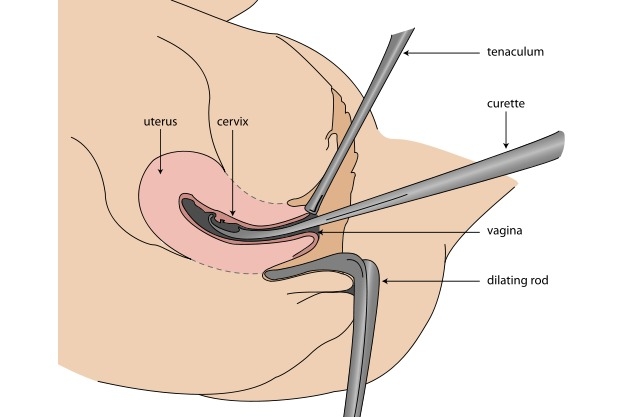
Dilation And Curettage
12 Nov 2018 | 5 min Read
Babychakra
Author | 1369 Articles
What is the Dilation and curettage procedure?
Dilation and curettage is a procedure in which the opening of the uterus, the cervix, is dilated and a thin instrument (curette) is inserted in the uterus to scrape the inner lining of the uterine wall; thus the name Dilation and curettage. The scraped tissue is then further examined in the laboratory.
Indications for dilation and curettage
A doctor may advise Dilation and curettage for the following conditions:
- Bleeding after menopause
- Abnormally heavy periods or long menstrual cycles
- Abnormal bleeding in between menstrual periods
- A doctor may also advise this test to detect conditions like uterine cancer, to treat a cervical or a uterine tumor, and to prevent infection and excessive bleeding after delivery or miscarriage. This procedure can also be used for termination of pregnancy or removing the remains of placenta after childbirth.
Pre-surgery care
The doctor will discuss the following details before beginning the procedure:
- The detailed procedure and the possible complications.
- The type of anesthesia that will be given for this procedure.
- Fasting period before the procedure, which is usually at least six to eight hours prior to the procedure.
- The preparation for the surgery such as shaving of the genital area.
- Stopping medications that can cause complications during the procedure such as blood thinners.
The doctor will order the following tests:
- Blood tests and urine test for a routine examination.
- Ultrasonography to check for any abnormal growth or remains of the placenta in the uterus.
The doctor will prescribe the following medications:
- In case of any heart disease, the doctor will prescribe antibiotics to prevent the infection of the heart valves by the bacteria from the vaginal wall.
- Medications will be given to clear the bowel.
- Misoprostol is given vaginally or orally to soften the cervix.
To prevent any complications, the doctor should be informed of:
- Any prescribed and non-prescribed supplements, herbs, vitamins, or medications
- Any allergies
- Alcohol intake of more than one to two drinks in a day
Procedure
- General anesthesia will be given just before the surgery. Local anesthesia or spinal anesthesia can also be used.
- The patient will be asked to lie on her back with her legs in stirrups.
- An instrument called speculum will be inserted in the vagina to give easy access to the cervix.
- The vagina will be cleaned using a cleaning solution.
- The doctor will then grasp the cervix with a clamp.
- The depth and angle of the uterus will be determined by inserting a thin and flexible metal piece called sound. These measurements are used to determine the distance that the curette can travel safely during the procedure.
- Usually, the cervix is dilated prior to the surgery by inserting a thin and smooth rod called laminaria, which is allowed to stay there for a certain time to dilate the cervix and then replaced with a thicker rod. This process of replacing the previous rod with a thicker rod is continued until adequate dilation of the cervix is achieved. At this stage, the patient may experience cramps and discomfort if the procedure is being done under local anesthesia. Once the cervix is adequately dilated, the curette can be inserted to scrape off the inner lining of the uterine wall. The uterine tissue is then sent to the pathology lab for testing.
Post-procedure care
- General anesthesia wears off as the procedure is done, but its effects may last for about four to six hours. The effects of spinal anesthesia will remain for one to three hours after the procedure.
- Some light spotting and cramping may be experienced for a few days after the procedure. The periods after the procedure may not occur at their usual time; they can be early or delayed.
Following are some do’s and don’ts once you are home after the laparotomy:
Do’s
You may experience cramps and bleeding for three to four days, but you can resume your routine in a day or two.
Visit the doctor for regular check-ups and discussion of the histopathology results of the uterine tissue.
Take the medications prescribed by the doctor. Your doctor may prescribe painkillers for dealing with the cramps post-procedure and an antibiotic to prevent infection.
Don’ts
Do not drive for at least a day after the procedure.
To prevent infection, avoid using tampons or products that go into the vagina or having sex until your doctor says it is okay.
Risks and complications
The complications of the Dilation and curettage procedure can be as follows:
- Cervical injuries: The instruments that are inserted into the cervix may cause cuts and wound to the cervix. These types of injuries may need stitches, application of medicine or pressure to stop the bleeding.
- Uterine perforation: It is the most commonly experienced complication that is experienced due to the instruments inserted in the uterus. Most times the perforations heal on their own, but sometimes the surrounding organs and structures are affected and need intervention.
- Infections: These are uncommon and can be treated with antibiotics.
- Bleeding: Excessive bleeding from the vagina may be experienced.
- Scar tissue formation: A scar tissue may be formed in the uterus when Dilation and curettage are performed after miscarriage or delivery.
Contact the physician immediately if any of the below-listed symptoms are observed:
- Excessive vaginal bleeding
- Abdominal pain
- Fever
- Vaginal discharge with a foul odor
Reference
https://www.acog.org/Patients/FAQs/Dilation-and-Curettage-DandC
A


Related Topics for you
Suggestions offered by doctors on BabyChakra are of advisory nature i.e., for educational and informational purposes only. Content posted on, created for, or compiled by BabyChakra is not intended or designed to replace your doctor's independent judgment about any symptom, condition, or the appropriateness or risks of a procedure or treatment for a given person.
